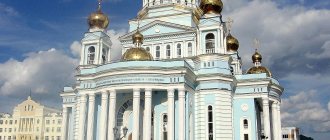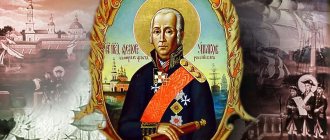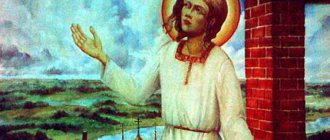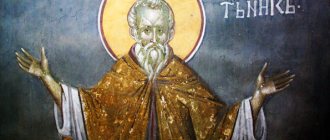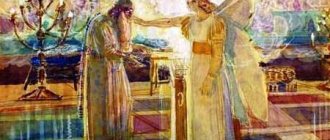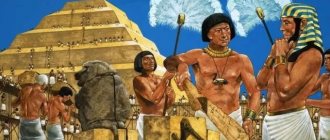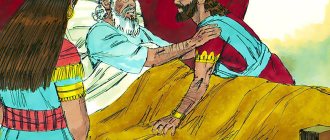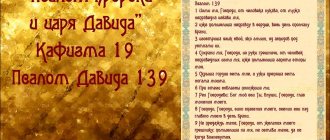Icon of the Holy Prophet David the King
The image of St. David will be a good name day gift for a man or boy with this name. The icon of the prophet David is the image of the ancestor of Christ Himself. He was the direct ancestor of Jesus Christ. At a young age, the future king tended sheep belonging to his father. He was a deeply religious, devout man. During the military campaign of the Philistines on the land of Israel, David defeated the giant Goliath in battle, which predetermined the outcome of the war. The news of this fight spread throughout all lands, and legends were created about it everywhere. After the death of King Saul and the death of his heirs, he was proclaimed king of Israel. First of all, David founded the new capital of God’s chosen people - the city of Jerusalem, which translated from Hebrew means “City of Peace.” David died a very old man. On his deathbed, he proclaimed that the world would soon be visited by the Messiah and Redeemer - the Lord Jesus Christ.
Ark of the Covenant
David's dream was to return the Ark of the Covenant. This shrine was stolen by the Philistines, but soon severe punishment befell those who touched it. Therefore, the Philistines wanted to return the Ark back to Israel. Thus, David's wish came true. According to the Bible, the king was so happy to see the Ark being brought back to Israel that he danced for joy in only a linen robe in front of all the people, forgetting his rank.
For this, the king's wife reproached him, saying that it was not appropriate for a king to behave this way. According to legend, she was punished for this by not being able to have any more children.
The king placed the Ark of the Covenant on holy Mount Zion. Under David's reign, Judah and Israel were united again. David abolished human sacrifices and worship of idols. Divine services became more musical, because the king himself composed psalms.
The king really wanted to build a temple for the Ark, but only his son could fulfill his desire. The Lord did not allow him to build the temple because the king shed a lot of blood.
Icon of David of Gareji
The Monk David of Gareji came to Georgian soil from Syria. He settled together with his student Lucian in the area near Tbilisi. Every week David came to Tbilisi and preached the Christian faith. One day he met a pregnant woman who claimed that the father of the child was Saint David. Later it turned out that local pagans persuaded her to make such a confession. Then David gathered all the believers around him and called the pregnant woman who had slandered him. David said that her wrongness would become obvious after she gave birth to the stone. This is what happened in the end. After this, David and his disciple went to the southeast of Georgia to a deserted place, where he founded the famous David-Gareji Lavra.
Orthodox Life
There are many types of asceticism, the mortification of one’s flesh for the sake of sedateness and elevation of the spirit: seclusion, desert living, fasting, wearing chains, pillar worship. One of the little-known ones is arborealism, when an ascetic performs his feat of prayer while on a tree.
Arborism, like pillarism, is a strict form of asceticism. It appeared in Mesopotamia in the 5th century. and was widespread in the East of Byzantium, without reaching Rome and the western borders of Byzantium. One of the saints who labored on the tree is the Venerable David of Thessalonica, otherwise called David Dendrite or David the Treeman. He is the patron saint of the city of Thessalonica (formerly called Thessaloniki) and the local holy fool.
The life of David the Treeman, who lived from 450 to 540, is known from two sources: “The Spiritual Meadow” by John Moschus (VII century) and an anonymous life written in the 8th century.
According to these works, between 465 and 470. David arrived from Mesopotamia to Thessaloniki and became a monk in the monastery of Saints Theodore and Mercury, which was located in the city wall of the northern part of the city and was called Kukuliaton (Κουκουλιατῶν), because its monks wore cloaks with a hood (kukuli), which is depicted on the icon. David is “a very virtuous, loving and strict man of life. He spent about seventy years in seclusion” (1). The virtuous life of the saint converted many people to Christianity and a pious lifestyle.
Such miracles were the result of the study of the Holy Scriptures and the intense asceticism, fasting and vigil of David, whose authority increased so much that they decided to elect him to replace the deceased abbot of the monastery. However, David refused. Wanting to gain reason and humility, and also inspired by the lives of the pillars Simeon and Daniel, who had read them in order to find peace with them after death, he decided to climb an almond tree that grew not far from the monastery church. Enduring all the variety of weather conditions (with fluctuations due to strong winds, the tree did not provide reliable shelter), David spent 3 years on the tree. “This symbolic number (three) corresponds, according to the life, to the three-year period during which the Prophet David received kindness, education and prudence after his prayers to God” (2). After three years, the Angel of the Lord appeared to David. He assured that his prayers had been answered and that his period of exploits as a dendrite had ended. The angel commanded the confessor to come down from the tree and continue the ascetic life in silence in the cell, continuing to praise and bless God in order to do “one more work of love.”
The fame of Saint David the Treeman intensified so much that the relocation to the cell took place in the presence of a large crowd of people, in the presence of laity and clergy, led by Archbishop Dorotheos I of Thessaloniki (d. after 520). The cell, according to the Spiritual Meadow, was located approximately 555 meters from the city.
Many people flock to the ascetic, asking for prayers and recovery. Two miracles of healing - a demon-possessed young man and a blind woman - are described in detail in the life. About the first it is said: “The young man was possessed by a demon and went to David shouting: “Free me, David, for the fire that comes from your cell is burning me.” Hearing this, David extended his hand through the small window of his cell and, touching the young man, said: “Our Lord Jesus Christ, the Son of the living God, commands you, the unclean spirit, to come out of His creation!” Having crossed the young man, the demon was expelled immediately, and that’s all , marveling, they glorified God, who has mercy on those who pray to Him and thank Him.” We read about one of the miracles - the adoption of monasticism by Abba Palladius from the Liphazomen monastery in Egypt - in “The Spiritual Meadow”: “One night, military guards guarded the walls of the city from barbarians. The warriors stood on the wall facing the side where the elder lived in seclusion. So the soldiers see one night that fire is coming from all the windows of the cell. Imagining that the barbarians had set fire to the elder’s cell, as soon as it was dawn, they rushed to the cell and, seeing that the elder was unharmed and the cell was intact, they stopped in amazement. The next night, the warriors again see fire in the elder’s cell - and this was repeated more than once. The extraordinary phenomenon became known throughout the city and throughout that country, so many spent their nights on the wall to see the wondrous fire. The phenomenon continued until the death of the elder. I myself saw this miracle not once, not twice, but many times. And I said to myself: if in this still world God glorifies His servants with such great glory, what will happen in the coming age, when their face will shine like the sun?! This, my children, was the reason why I took on the monastic form” (3). David lived in his cell for about 20 years (from 500 to 520)
Important historical events take place in the empire, the transfer of the capital of Illyria from Thessaloniki to Justiniana the First. And David Drevesnik plays an important role in this.
After the death of Archbishop Dorotheus of Thessaloniki, his successor Aristides of Thessalonica comes to David with a request from himself and all Thessalonians, as a sign of love, to go to Constantinople to ask Emperor Justinian I (527–565) not to move the capital of Illyria to Justiniana the First, because this would lead to reduce the prestige of Thessaloniki. Aristide himself cannot go to the capital because he does not want to leave the city without a shepherd in the face of a barbaric threat. David takes the blessing of the archbishop and, together with his two students, Theodore and Demetrius, goes to Constantinople. In the capital, where his fame was great, David was greeted with respect and honor. Gray-haired to the waist and with a beard reaching to the ground, the old man looked like the Old Testament Abraham. Since Emperor Justinian was absent, the Thessalonica embassy was received with special honor by Empress Theodora, sending dignitaries to meet them, giving them a warm welcome and settling them in the palace. David began his request to the emperor in the Senate by taking a coal and showing respect by showing the emperor and those present without burning his hands. The request was granted
A few days later the emperor released David. On the way home by ship, when the monastery came into view, the saint prayed, said goodbye to his disciples Theodore and Demetrius, and gave up his soul to God.
Archbishop Aristides ordered the remains of David to be transferred to the monastery and placed in a coffin. After 150 years, the abbot of the monastery, Dimitri, decided to dig up the relics of the monk in order to take some for himself, but the gravestone split into many fragments, frightening the workers. Abbot Demetrius took this as the saint’s reluctance to have his remains divided. The successor of Abbot Demetrius, student Sergius, repeated his teacher’s attempt and after lengthy prayers, excavating the grave, he found the incorruptible relics of David the Treeman, and took several hairs from his beard and head as a relic.
The relics of St. David the Treeman are located in the monastery of St. Theodora of Thessalonica in Thessalonica.
On icons, the saint is often depicted as a gray-haired old man with waist-length hair and a beard reaching to the ground, wearing a cloak with a hood, sitting on the branches of a tree. In one of the paintings in the Chora Church in Constantinople, the Monk David is depicted in the funeral chapel and is equidistant from Zacchaeus on the fig tree on one side and from Moses, who saw the Burning Bush, on the other.
Archpriest Andrei Ukhtomsky, candidate of theology, teacher of the KDA
Notes:
1. John Mosch. Spiritual meadow. 69. The life of Abba Palladius and the Solunsk hermit David // El. resource: https://azbyka.ru/otechnik/Ioann_Mosh/lug-dukhovnyj 2. Hermits in the Trees: The Dendrites // El. resource: https://citydesert.wordpress.com/2014/01/04/hermits-in-the-trees-the-dendrites/ 3. John Mosch. Spiritual meadow. 69. The life of Abba Palladius and the Solunsk hermit David. // El. resource: https://azbyka.ru/otechnik/Ioann_Mosh/lug-dukhovnyj
What does it help with?
According to the nature of Orthodox deeds, saints are traditionally divided into faces (classifications, categories): apostles, equal to the apostles, saints, prophets, martyrs (great martyrs, venerable martyrs, holy martyrs), righteous, reverend, holy fools, holy believers, confessors, etc. Think about what you are could follow the example of their saint. Try to pay attention to their exploits and imitate them a little with your life, then the saint will help you.
Ask your heavenly patron David for everything, pray for all your needs. Try to live a church life. The David icon especially helps in the fight against evil thoughts. Start reading your daily prayer rule: morning and evening prayers, which are in every prayer book. If it’s difficult to read, go through the rosary with the Jesus prayer “Lord Jesus Christ, Son of God, have mercy on me, a sinner” (one prayer - shift one bead). Also, if you are in serious condition and cannot read or watch movies, pray the Jesus Prayer more: just lie down and touch your rosary while praying. This is calming, and prayer will enlighten and heal you with the grace of God.
If possible, visit the temple and pray during the service. If you have not yet been baptized, accept Holy Baptism; either the church store employees or the priest will tell you about this. If you are baptized, you can confess to a priest, remembering your sins, and during the morning service - Liturgy - partake of the Holy Mysteries of Christ, having prepared with prayer. If you are seriously ill, you can invite a priest to the room; this is common practice in modern hospitals.
Take from the church or ask your relatives to bring from there a prosphora (given when they pray for your health at the Liturgy; for this, your relatives can write a note “On health”) and holy water (this is drinking water blessed at a water blessing prayer, it is distributed free of charge in every church ).Dear Brothers and Sisters, we remind you that it is easy to buy an icon of David at a low price in our Orthodox shop!
Path to the monastery
This famous monastery, which has now become a popular destination for pilgrims, is located 45 kilometers south of Sagarejo along a winding road. It is a little closer - about 30 kilometers - from Gardabani, but this road is rarely used because it is very broken, and you can spend much more time overcoming it.
Previously, there were buses from Tbilisi to Gareji, but they have now been canceled. You can take a minibus to Sagarejo, and from there call a taxi directly to the monastery. You can arrange with some taxi drivers to get to the temple directly from Tbilisi.
13 kilometers from this holy complex is the village of Udabno, which literally translates from the Georgian language as “desert”. There is an asphalt road leading to it, but it can only be reached by personal transport.
From Sagarejo you can order a taxi to the monastery for approximately 35 GEL. For this money they will take you there and back, taking into account a two-hour wait.
In 2014, a bus from Tbilisi appeared, which departs daily. You can board it in the area of Freedom Square at 11 a.m., on Pushkin Street. The fare is 25 GEL. For this money you will be taken to the monastery complex, and three hours later you will be taken back. On the way, the bus makes one stop at the Oasis Club cafe. The flight operates only during the tourist season, until approximately mid-October.
Prayer to Saint David
There are few rules for reciting prayers, although you can address the Lord and saints anywhere. Prayers are read in front of the icons, in the “red corner”, where the home iconostasis is usually located. Cross yourself, looking at the icon, bow. Now you can read the prayer and supplement it by praying in your own words. Read the prayer with attention, stay in communion with God. After prayer, you can kiss the icon according to tradition - this is called “kissing the icon”: cross yourself twice, kiss the hand or the edge of the clothing of the image on the icon, cross yourself again. May the Lord protect you with His grace!
After prayer, you can kiss the icon according to tradition - this is called “kissing the icon”: cross yourself twice, kiss the hand or the edge of the clothing of the image on the icon, cross yourself again. The prayer to the saint can be read online using the text below:
“Pray to God for me, holy saint of God David, because I diligently ask for your intercession, an assistant in everything and a prayer book for my soul.”
Battle with Goliath
Photo: Pixabay.com
Chronicles indicate that Goliath was a warrior of enormous stature and went into battle dressed in armor. His head was protected by an iron helmet, and he held a spear in his hands. David had no armor at all, and his weapon was an ordinary sling. To the people watching the fight, it seemed that the outcome of the battle was already a foregone conclusion. However, the Lord did not leave David with his help, and the stone sent by the young man from a sling hit Goliath squarely in the forehead and killed him.
Since then, David has won many more victories and wisely ruled his people. He died after forty years of reign and was buried in Jerusalem. In Orthodoxy, the image of David has become an example of a king who personifies the greatness of his people and a symbol of unshakable faith in the Lord.
( 10 ratings, average: 4.60 out of 5)
